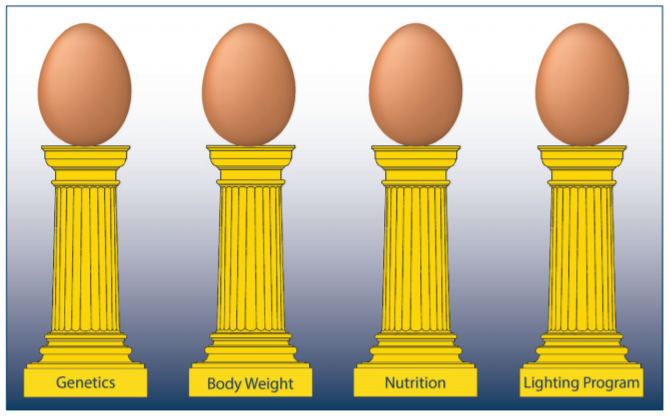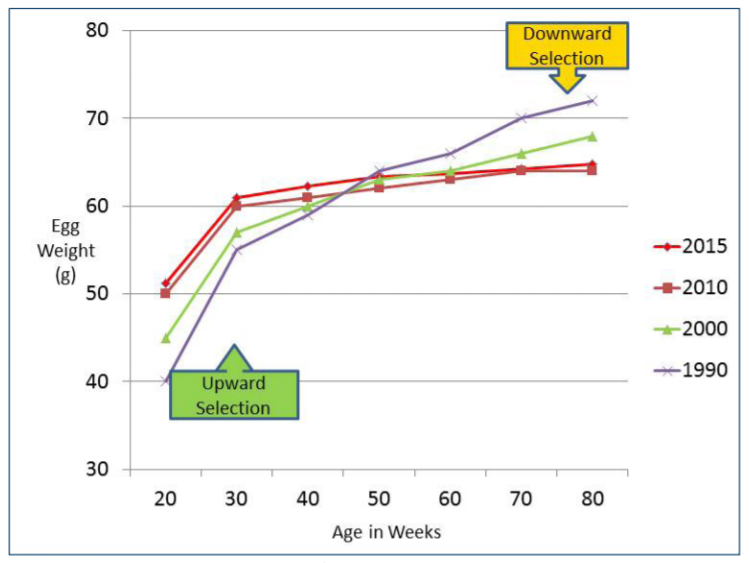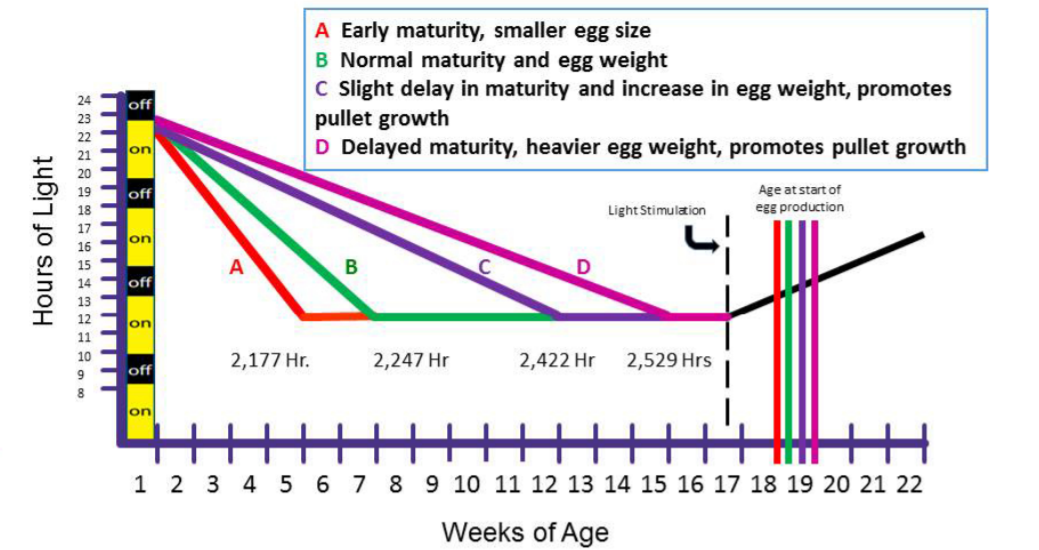



Optimising egg size in commercial layers
Each commercial variety has a genetically determined range of egg size, and within this range, environment plays an important role in the expression of egg size. Genetics, body weight management, nutrition, and lighting programs are the four pillars of egg size and are useful tools for the egg producer to change egg weight profiles to best supply the optimum egg size to a market.The four pillars of egg size
1. Genetics
Hy-Line is working at the genetic level to create commercial lines that have different egg size ranges. Egg weight is a heritable trait (~40%) that responds well to genetic selection. About 60% of egg size variation, however, is due to non-genetic factors (nutrition, management, etc.). These non-genetic factors can be manipulated by egg producers to achieve the desired egg size profile.
Hy-Line has been collecting egg weight data and selecting on egg weights for decades. Historically, egg weights have been collected periodically throughout a hen’s lifetime. Currently, Hy-Line weighs the first three eggs a hen lays, eggs laid mid cycle, and eggs laid late in the cycle. The Hy-Line Research department uses these egg weights to select for a more desirable shape to the egg weight curve. Specifically, they select to increase early egg weights, hold mid-cycle egg weights constant, and decrease late egg weights (Figure 1).
Figure 1. Egg weight changes for Hy-Line Brown, 1990–2015.
Egg numbers and breaking strength have a negative correlation with late egg weight. As Hy-Line varieties continue to improve late persistency and shell strength, the egg sizes at later ages will come down. To help adapt to this selection pressure, Hy-Line is relaxing the selection pressure to reduce late egg weight to ensure that sufficient egg size and egg mass is available in the genetic potential of the birds.
2. Body weight
An important factor in egg weight is the pullet‘s body weight at maturity. Heavier hens tend to lay more eggs throughout the production period and will have greater flexibility in adapting different egg size profiles. Body weight is affected by many factors, including beak trimming, vaccination program, transfer, disease challenges, pullet lighting program, space allotment, and nutrition. Due to the direct affect of body weight on egg weight, the achievement of flock target body weight with good flock uniformity is important for egg size management. For more information on target body weights for each Hy-Line variety, see Management Guides at www.hyline.com.
3. Nutrition
Nutrition during the rearing and laying period has a critically important role in egg weight. Proper rearing nutrition allows the hen to achieve or exceed the standard body weights. Changing the rearing diets based on attaining body weight standards (and not bird age) will best match the diet to the actual nutritional needs of the pullet. For more information, see the "Growing Management of Commercial Pullets" technical update at www.hyline.com.
During the laying period, the specification of diets can be used to manage egg size. Energy, methionine/cystine, other digestible amino acids, linoleic acid, and total fat can directly affect the egg size. These components can be specified in layer diets to influence egg size downwards or upwards.
The protein content of the diet should be balanced to ensure the amino acids are utilised efficiently by the bird. Unbalanced protein can result in poor utilisation of amino acids and suboptimal egg size.Breghendahl (2008) estimated the "ideal amino acid profile" and determined that the ratio of methionine to lysine should be a minimum of 47:100 to support maximum egg mass. All other amino acids should be balanced relative to lysine to ensure egg size is optimised as efficiently as possible.
To avoid excessively large egg size and weak egg shells later in the laying period, these nutrients are gradually reduced after peak egg production (30 weeks of age). Pushing nutritionally for greater egg size could result in thinner shells and more cracked eggs if mineral requirements of the bird are not adequately provided for.
Management for larger egg size should include nutritional considerations in rear for subsequent shell quality and bone strength (i.e. pre-lay diet).
Egg weight can be regulated through use of a phase feeding regime. Optimal egg weight will be easier to achieve when formulating feed according to egg weight or egg mass and constantly updating the formulas according to these parameters. This tool can be very helpful either to increase egg weight on earlier production, or to control egg weight on late production.
Be aware that not only nutritional levels, but all aspects of nutrition management can affect egg size. Feed particle size, water intake, water temperature, and feeding schedule can affect daily feed intake and nutrient intake as a consequence.
Heat stress can depress egg weight. High environmental temperature above the thermoneutral zone (> 33°C) has a depressing effect on the bird’s feed intake. The result can be a shortfall in nutrients like protein (amino acids) and energy, which will decrease egg weight. It is common to see decreased egg size as a consequence of heat stress. Appropriate adjustments in feed formulation to match the actual bird feed intake and mitigation of heat stress conditions can minimise this depression of egg size. In environmentally controlled houses, lowering the environmental temperature will increase feed intake and support egg weight.
4. Lighting programs
Chickens are responsive to changes in day length, and this has a significant effect on egg production and egg size (Figure 2). Slow step-down lighting programs (C and D) during the rearing period provide the pullet with more light hours to eat and grow. At the same time, these slow step-down lighting programs can also delay maturity and increase egg size.
Figure 2. Effect of different lighting programs on total hours of light, age of sexual maturity, and egg
weight.
Faster step-down lighting programs (A and B) provide fewer light hours and slower growth but earlier sexual maturity with smaller egg size.
Age of light stimulation and body weight are interacting factors that help determine the onset of egg production, as well as egg size. Light stimulation should be done based on the flock’s body weight and uniformity. Generally, early light stimulation at lighter body weights will accelerate maturity and decrease egg size; while later light stimulation at heavier body weights will delay maturity and increase egg size. Generally, the hen has the ability to produce a certain egg mass. As egg weight is changed, the egg number tends to change inversely to keep the egg mass constant.
Management tips to optimise egg size in a market
Management for larger egg size:
1. Select a commercial variety with a heavier egg weight profile. Hy-Line W-80 Plus is the large egg version of W-80. The Hy-Line Brown can be customized to influence the egg weight profile.
2. Use a slower step-down lighting program in rear. (12 weeks)
3. Light stimulation at a heavier pullet body weights. (W-80 Plus: 1.25 kg; Hy-Line Brown: 1.40 kg; W-36: 1.27 kg)
4. Make smaller gradual reductions in energy and methionine/cystine during the phase feeding program.
- Use feed formulation that provides 10–15% higher digestible amino acid intake (mg of digestible amino acid per bird per day) than recommended in the Hy-Line guide. Increase the ratio of methionine + cystine to lysine to be >90%.
- Linoleic acid has a positive impact on egg size. For increased egg size, use 1.5 g linoleic acid per bird per day. Use sources of supplemental oil which are higher in linoleic acid, like soybean oil or flaxseed.
- Increase total and supplementary fat content in the diets. Studies have shown that at the same linoleic acid levels, birds consuming a higher amount of total fat will produce larger eggs.
- Keep an optimal energy intake. In situations of deficient energy intake, laying hens will utilize protein and amino acids as an energy source, resulting in less amino acids available for optimal egg size. Many situations of low egg weight are due to low energy intake. Overfeeding energy above recommended amounts tends to depress egg weights, as a consequence of lower feed intake.
Management for smaller egg size:
1. Select a variety that has a regular egg weight profile. (Hy-Line Brown, Silver Brown, W-80, or W-36)
2. Use a faster step-down lighting program in rear. (7 weeks)
3. Light stimulation at a lighter pullet weight. (W-80: 1.17 kg; Hy-Line Brown: 1.30 kg)
4. Make larger gradual reductions in energy, methionine/cystine, and total digestible amino acids during the phase feeding program.
- Nutritional management for controlling egg size is more complex and generates slower results than managing for increased egg weight.
- Reduce methionine + cystine to lysine ratio (<84%). This reduction should be done gradually to avoid reduction of egg production as well.
- Control total digestible amino acid intake. Studies have shown that a reduction of intake of all amino acids can be more effective in controlling egg weight than reducing only methionine and methionine + cystine.
- Limit linoleic acid intake to 0.9 g/day per bird. Change to an oil source with lower linoleic acid content, such as palm oil.
- Start to control egg weight with phase feeding at least 2–3 g before the desired egg weight. Provide clear objectives of the amount of cumulative amino acid intake per egg weight phase you desire.











